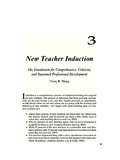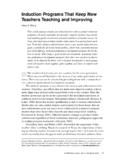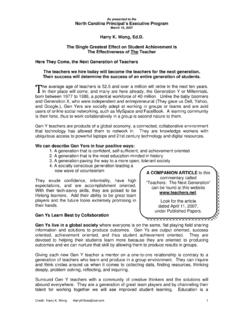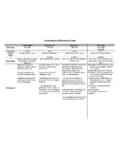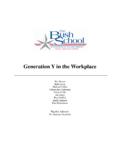Transcription of Teachers: The Next Generation - FDSFoundation.org
1 Teachers: The next GenerationHarry K. Wong and Rosemary T. WongAccustomed to social networking and collaborative environments, today's young educators seem naturally inclined toward group structures. Meet Generation Y, the millennials, a potential workforce of as many as 40 million people born from 1977 to 1986 ( Census Bureau, 2001). Some of these individuals have elected to become teachers, and although many have passed the five-year mark in their careers, a new wave is just now entering the of them were sitting in the back of the room when I spoke to a group of administrators at the Staff Development Council of Ontario's conference in Toronto, Canada. They appeared to be in their early 20s, and they were chattering away while simultaneously taking notes. In fact, they were in such a happy state that I could not resist stepping I approached, one of them immediately and apologetically declared, "We were not being rude, talking while you spoke.
2 What you said was so good and so implementable we can't wait to go back to school and form a group!"This is the style of today's teachers. They are products of an increasingly global economy, where knowledge is power and laptop computers often provide the quickest means to attaining both. Many of today's young teachers not only have access to millions of digital resources, they also have at their fingertips thousands of professional and social networks. They are receptive to working in teams, and they are good at it. They do not blink at the mention of blogging, "Googling," or using Wikipedia. Indeed, learning communities are their forte. In with the NewGeneration Y is dramatically changing the composition of today's teaching staffs. Demographically, women continue to dominate the profession, but as millions of baby boomers enter retirement age, the faces of today's K 12 teachers are younger than New York Times (2006) reports that in New York public schools more than half of the teachers have less than five years experience.
3 In Sacramento, Calif., a significant percentage of public school teachers currently have less than five years of experience. During the 1999 2000 school year, almost 30 percent of Sacramento's public school teachers had 20 or more years of experience, while 18 percent had two or fewer years on the job. By 2004 2005, those numbers had flipped just 15 percent of Sacramento City Unified School District teachers were 20-year veterans; 25 percent were novices. From Outer Space to MySpaceLet's examine four major groups of Americans, while focusing on how we can all work together to improve student has been written about the silent Generation , characterized as heroes by former NBC News anchor Tom Brokaw in his book, The Greatest Generation . Even more has been written about baby boomers, many of whom marched for civil rights and world peace but are today characterized as overly materialistic, having produced massive wealth through companies like Microsoft, Apple, and X, initially referred to as slackers in films and numerous magazine articles, was born to boomer parents with the highest collective divorce rates in American history.
4 They found themselves in a debt-riddled economy and plunged into historically high child poverty rates. Left to fend for themselves, many quickly shed their grunge shirts and slacker labels and became results-oriented entrepreneurs, producing companies like Netscape, Yahoo, Amazon, and Y is being dubbed "global citizens." These millennials have been told by parents, teachers, and Internet collaborators that they can make a difference in the world and many of them are. In fact, they may be the most socially conscious Generation since the baby boomers. In 2000, more than half of high school students and 75 percent of college freshmen reported doing volunteer work (Martin & Tulgan, 2002), including teaching in poverty-stricken urban centers. Indeed, many of today's young people believe that education is the key to their success, and with their tech-savvy skills, they are poised to be lifelong learners.
5 Add to this their ability to adapt as team players, and the future looks promising in their hands. Generation Number in Workforce (in millions, 2001) Percentage of the Workforce Silent Generation (born before 1946) Baby Boomers (1946 1964) 42% Generation X (1965 1976) Generation Y (born 1977 1989) 21% Source: From Managing the Generation Mix: From Collision to Collaboration (p. XIV), by C. Martin and B. Tulgan, 2002. Amherst, MA: HRD Press. Copyright 2002 by RainmakerThinking, Inc. Adapted with permission. Flying SoloReturning to the Toronto conference for a moment, more than 250 staff developers and administrators talked about how they were going to mentor the next Generation of teachers, offering them one-on-one relationships. This age-old approach appears contrary to the sensibilities of a Generation of new teachers accustomed to group-learning environments.
6 Studies have shown that in many school districts, mentoring is not only carried out one-on-one, but is done in isolation, with no coherence to any district or school curriculum, goals, or these staff developers, all mostly in their 40s to 60s, were asked how they would mentor new teachers, they collectively said, "We will mentor them for educational inquiry."Presumably, inquiry means deep thinking. Hardly anyone would argue against teaching young people to conceptualize and think with deep understanding; however, the one-size-fits-all teaching of inquiry with no achievement outcome expectation reflects a time in history when it was presumed that young people had to be taught how to think. Most millennials entering the teaching profession today arrive with excellent critical-thinking skills. Rather than mentoring them one on one, it would be more beneficial to create goal-oriented study groups, whereby young teachers could collaborate and develop proficiencies in curriculum and academic baby boomers changed history with their rebellious ethos, largely through civil rights marches and antiwar protests.
7 "Gen-Xers" followed with their self-sufficient, accomplishment orientation hallmarks of deep thinkers. The changing demographics of today's students demand flexibility and new approaches to teaching and learning. Outcomes, such as inquiry, are important in so far as they lead to improved student learning (Noyce, 2006). The same principle applies to mentoring new education system typically views teachers as independent operators, encouraged to be creative and expected to do a good job behind closed doors. Collaboration is rare. Worse yet, new teachers seldom see another classroom in action. Loneliness and lack of support further exacerbate the frustrations of beginning teachers. To ask a Generation Y teacher to go solo in a networked world is writing that teacher 's epitaph, and it might as well read: "Doomed from the start."Why are we encouraging today's K 12 teachers to create group-learning environments within their own classrooms while simultaneously telling those same teaching professionals they will learn best in one-on-one mentoring programs?
8 "Schools would do better to rely less on one-on-one mentoring and, instead, develop schoolwide structures that promote the frequent exchange of information and ideas among novice and veteran teachers," says Susan Moore Johnson of the Project on the next Generation of Teachers at Harvard's Graduate School of Generation Y teachers with a community of creative thinkers and the solutions will abound. Professionals from marketing managers to software engineers rarely work alone they work in teams. As should teachers, says Kathleen Fulton, director of Reinventing Schools for the 21st Century for the National Commission on Teaching and America's Future. "Teachers should be in teams, working collaboratively around problems identified in their schools that are related to their students," Fulton stated in an article in the American School Board Journal (Rivero, 2006). Collaboration is the most effective way for teachers to learn, and teachers learn more in sustained teacher networks and study groups than with individual mentors (Garet, Porter, Desmoine, Birman, & Kwang, 2001).
9 Most people understand that businesses continue to train workers in teams with specific outcomes in mind; likewise, schools will see improved student learning if they harness the collective intelligence, creativity, and genius of their teachers in teams. Beating the Individual OddsIn Beat the Odds: Why Some Schools with Latino Children Beat the Others Don't, the Center for the Future of Arizona reported that success, in both high-achieving and underperforming schools, had little to do with funding, class size, reading programs, parent involvement, or tutoring (Waits, 2006). The characteristics of schools that beat the odds follow:l They assessed and They used the results to teach and They did not stop until they found a way for every student to grasp each C. Kennedy School in the Creighton School District of Phoenix, Ariz., is one school that was recognized.
10 The 1st grade teaching team, consisting of Patricia Hicks, Karen Schnee, Julie Kunitada, and Jenny Lopez call themselves "experts in the trenches." They teach English language learners and report that their success "comes from evaluating test scores regularly, adapting our teaching to each student's needs, and not giving up until they get it right."When a new teacher joins the staff, the other members of the team bring her up to speed quickly by reviewing yearly objectives and discussing how to reach goals. The teams at the school meet weekly. They have created learning communities of teachers who tackle problems and issues. The 1st grade team members state: "Our team is flexible and pliable, stubborn, and persistent. We accept ownership of the children and believe that all children can learn. We never give up!"By meeting regularly, discussing student needs, fostering collaboration, and harnessing collective intelligence, L.
